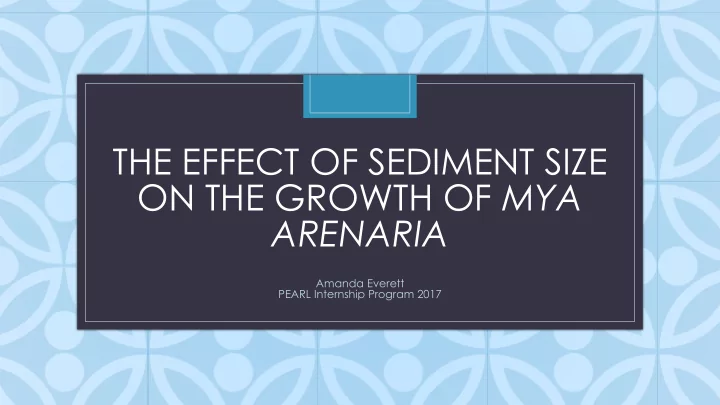

THE EFFECT OF SEDIMENT SIZE ON THE GROWTH OF MYA C ARENARIA Amanda Everett PEARL Internship Program 2017
Mya arenaria • Also known as softshell clams, steamers, piss clams and longnecks • Spawn twice a year, once in the fall and again in the spring. • Play a roll in filtration just like oysters • Shell is very fragile.
Aquaculture Industry • Not currently an aquaculture product in Maryland. • Is a product in northern states like Maine and Massachusetts • Currently has a large economic value to the northern states • Is a fishery product in Maryland and has a lot of value, but farmers need a more stable source of product.
Economic Value of Mya • Established market globally, where they are plentiful and scarce. • In 2015 the soft shell clam fishery was the second most important in dockside value, $22.5 million, • only behind the American Lobster in Maine (Wilson, Grendler, Dunlap-Smith, Beal and Page, 2016). • MD dockside value of $80 to $100+ a bushel for the past dozen years, with retail values being even higher (Homer, Dungan, and Tarnowski).
Previous Work • Sand and mud had faster growth rates than gravel • Maine field study (Newell & Hidu, 1982). • Clams grew better on larger substrates (gravel and oyster shell) where they had protection from predators • Virginia field study (Bovery, 2010)
Parameters • Mya arenaria can tolerate salinities ranging from 4 ppt to 15 ppt. The Chesapeake bay’s salinity ranges from 0.5 ppt to 30 ppt, (Chesapeake Bay Program). • Adult Mya hit lethal temperatures at 32.5- 34.4 degrees C and can survive low temperatures just beyond freezing.
Question • Do Mya arenaria grow at different rates in different sediment sizes? • What sediment size should be targeted for the best habitat to grow Mya in, in the Chesapeake Bay area?
Hypothesis • H A : Mya will grow larger in sediment sizes less than 300micrometers. • H o : There will be no mean difference in the growth of the clams, between the different sediment sizes.
Sediment Sizes • Sediments were chosen to match the sediment types farmers have available in the Chesapeake Bay. Samples of the sediments were pulled locally and separate using different size sieves. • <300 Micrometers • <300-<600 micrometers • Mix of the <300 and <600 • Control (Empty, with no sediment)
Methods Front • 3 replicate tanks • 4 containers in each, <300, <300-<600, Mix, & Control • All animals from same cohort • Experiment ran from 6/12-7/31 Back • Daily • Temperature, salinity, dissolved oxygen, and pH levels • Weekly • Clam survival, length, wet weight and height
Tank Sediment Row Animal 0 1 2 3 4 5 6 Tank <300 Front 1 1 2 Back 1 Standardizing growth, we will use a split plot nested repeated measures ANOVA to test the change in shell length, height and weight of the clams in the various sediments. 2 300-600 Front 1 2 H 0 : µ <300 = µ 300-600 = µ <600 = µ empty Back 1 H A : at least two means are significantly different 2 mixed Front 1 2 Tank (3-1) df Tank A, Tank B, Tank C Back 1 Sediment (4-1) df Mixed, Empty, Small, Large 2 Empty Front 1 Row (2-1) df Front, Back [control] 2 Animal (2-1) df 1,2 Back 1 Between subjects (animal) df Time (7-1) df 0-6 weeks 2 Tank <300 Front 1 tank 2 2 2 2 Back 1 sediment (Tank) 3 x 6 18 2 Row(sediment(tank)) 2 x 3 x 6 36 300-600 Front 1 2 Animal(row(sediment(tank)) 2 x 2 x 3 x 6 72 Back 1 2 mixed Front 1 Within subjects df 2 time 6 6 Back 1 2 Animal(row(sediment(tank))x time 72x6 432 Front 1 2 Empty Back 1 [control] 2 Front 1 2
Growth Rate
Final Survival A B C small Mixed large empty small mixed large empty small mixed large empty front back front back front back front back front back front back front back front back front back front back front back front back 1 1 1 2 1 1 2 1 1 2 1 2 1
Discussion • Overall, data suggest sediment size may effect the growth of the clams • Position in tank may have effected growth and survival • Low oxygen coupled with temperature most likely increased likelihood of death • Animals not involved in experiment also died
Future Experiments • More replicates • Bigger temperature and dissolved oxygen range • Need containers that don’t impact growth
Future Farmers • Based on our results we are not certain where the best location is • Blue crabs may be an issue • Site selection is important • Temperature and dissolved oxygen levels could be an issue
Questions?
Sources • THE EFFECTS OF SEDIMENT TYPE ON GROWTH RATE AND SHELL ALLOMETRY IN THE SOFT SHELLED CLAM MYA ARENARZA L.’ • Bovery, Caitlin Mary, "Habitat Preferences and Predation of the Softshell Clam, Mya arenaria, in the Lower Chesapeake Bay" (2010). College of William & Mary Undergraduate Honors Theses. Paper 724. • John J. Wilson, Janelle Grendler, Azaline Dunlap-Smith, Brian F. Beal, and Shallee T. Page "Analysis of Gene Expression in an Inbred Line of Soft-Shell Clams (Mya Arenaria) Displaying Growth Heterosis: Regulation of Structural Genes and the NOD2 Pathway."International Journal of Genomics. Hindawi, 16 Oct. 2016. Web. 07 July 2017. • Homer, Mark L., Christopher F. Dungan, and Mitchell L. Tarnowski. "ASSESSMENT OF CHESAPEAKE BAY COMMERCIAL SOFTSHELL CLAMS Mya Arenaria and Tagelus Plebeius WITH EMPHASIS ON ABUNDANCE AND DISEASE STATUS." (2011): n. pag. Web. • Braham, Barbara J., and Perian L. Dillion. "Softshell Clam." Species Profiles: Life Histories and Environmental Requirements of Coastal Fishes and Invertebrates (Mid-Atlantic) (1986): n. pag. Web. • “Historical record of water temperatures in the Chesapeake Bay” NOAA, 2016. http://www.ccpo.odu.edu/ccslri/baydata.pdf
Recommend
More recommend